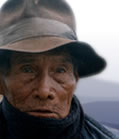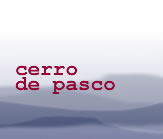 |
 |
||
 |
|||
|
RELATED THEMES culture and customs festivals OTHER LOCAL THEMES BACKGROUND |
spiritual beliefs
There is much in these interviews on people's beliefs and on the history to them. There are references to Inca and pre-Inca traditions, as well as the Catholic faith. Each village has its patron saint and, it is often remarked, such celebrations draw back urban migrants year after year: "when they go and live in other cities the children from Quiulacocha come back for the fiestas and celebrate with their brothers in the community. They never forget the saint's days. But we keep our customs here I think, more than in the cities" (Peru 7). Not surprisingly, many festivals blend Catholicism with agrarian traditions. And despite the changes to landscape and lifestyle which the mining industry brought with it, people continue to celebrate a strong spiritual bond with the land, and especially with Jirca - "Grandfather Mountain", "the Great Shepherd" - who according to belief, looks after the animals. A number of narrators describe the annual festival: "When we get there, we dig a hole to bury the offering to the Jirca in the name of our sheep and llamas so we can be sure that nothing will happen to them and they won't be short of the main thing, grazing. We bury some coca, cigarettes, sweets and liquor for the Jirca. We chew coca and drink spirits to please the Jirca so he will look after our animals" (Peru 31). There are also some beliefs specifically connected with the mining industry, including one that women must not enter the mines because tragedy will follow, and different legends about who first discovered the region's mineral wealth. Alejandro (Peru 32) retells several stories his father told him about restless and harmful spirits, some of whom haunt the mines, as well as the story of the Muqui: "It's a little dwarf who likes to play with children, not with the workmen, but the company wouldn't let children in. It's a mythical way of explaining what mining life is like, with its worries and dreams of good-fortune, because the Muqui doesn't exist." A young woman also speaks of the Muqui: "It's a kind of ghost in the mines, it appears to the miners and is a bit of a joker sometimes. But it's harmless" (Peru 27). The Day of the Dead is another powerful tradition. As one man, who has much to say on local customs and beliefs, explains: "Here in the Andes, the first and second of November are days when we feel, perhaps subconsciously, we'll be with our absent loved ones again. That's why big family groups invade the cemeteries. after saying a prayer and singing.we decorate the graves and plant things. The families also eat local dishes, like charquican (dried llama meat). Everyone eats round the grave, and drinks a little beer or maybe a little caliche" (Peru 25). quotes about spiritual beliefs"Well, [the animals' festival] is in my opinion is a mixture of customs from the Inca period and Catholicism, the religion introduced by the Spanish. When we lay the table we include coca, cigarettes, fruit, liquor and the other things we need. Apart from this we also lay a table for the mountain, the Jirca. It's not the same table as the one for the cows, sheep and llamas, no it isn't. We prepare them both together and in the meanwhile we drink and chew coca. The table for the mountain is separate, we set it up at a little cave or boulder. [It is] an offering to the mountain to increase the cattle and to ensure all goes well with no farming problems over the year." "[The Day of Dead] has been celebrated for a very long time throughout this region, that's the way our parents taught us. We usually go to the cemetery on the 1st and 2nd of November, we sing and pray. At night we lay a table with all the foods the dead person liked: a mazamorra (maize porridge), all their favourites. We also believe that on the 2nd at 12.00 noon the dead person's soul comes to eat at the table so you have to leave it free for them - whether it's a corner of the living room or one side of the dining room." "What is the Muqui? The Muqui is about 80 cm to a metre in height. If you catch a Muqui at work he will do all your work for you and you can sleep or relax.They say the Muqui and other mining characters are jealous and they won't let any women into the mine. That's why no women to date have entered the mines in the Cerro or in Bolivia, not one woman engineer, researcher or journalist. They've only reached the surface but none have gone down into the galleries." |
|